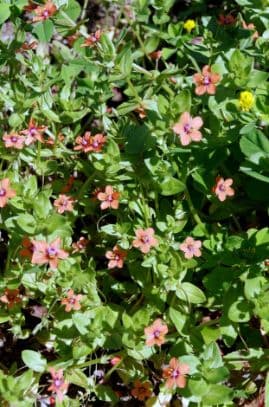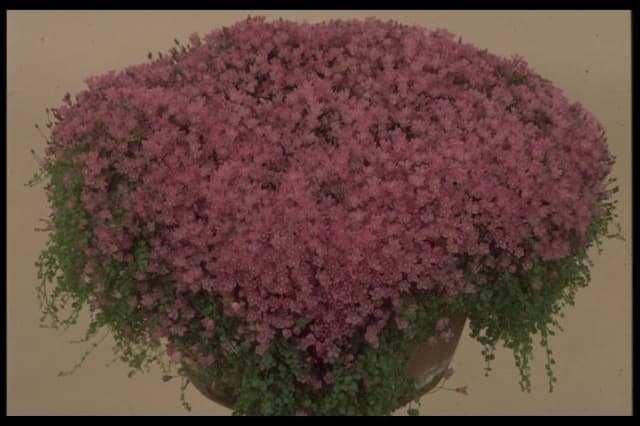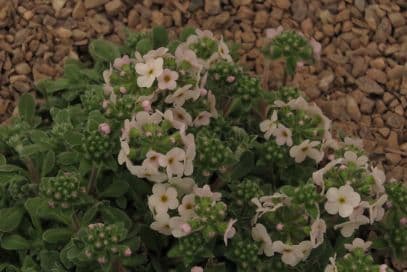Primrose 'Dunbeg' Primula vulgaris 'Dunbeg' (Kennedy Irish Series) (Pr/prim)

ABOUT
'Dunbeg' is a perennial forming a rosette of dark bronze, tongue-shaped leaves. The flowers, carried on individual stems, are pale yellow with deeper yellow centres
About this plant
 Names
NamesFamily
Primulaceae
Synonyms
Irish Primrose, Kennedy Irish Primrose
Common names
Primula vulgaris 'Dunbeg' (Kennedy Irish Series) (Pr/prim).
 Characteristics
CharacteristicsLife cycle
Perennials
Foliage type
Evergreen
Color of leaves
Green
Flower color
Varies
Height
6 inches (15 cm)
Spread
8 inches (20 cm)
Plant type
Herb
Hardiness zones
5
Native area
Europe
Benefits
 General Benefits
General Benefits- Ornamental Value - Primula vulgaris 'Dunbeg' has attractive flowers and foliage, bringing color and visual interest to gardens or indoor settings.
- Easy to Grow - It is suitable for novice gardeners because it’s relatively easy to care for and maintain.
- Compact Growth - The plant's compact size makes it ideal for small gardens, borders, and containers.
- Long Flowering Period - It blooms for an extended period, often from late winter to spring, adding color to the garden when few other plants flower.
- Attracts Pollinators - Its flowers are attractive to bees, butterflies, and other beneficial insects, supporting local ecosystems.
- Variety of Uses - Can be used in rock gardens, as border plants, in woodland settings, or as part of a perennial bed.
- Tolerance of Different Conditions - It can tolerate a range of soils and partial shade, being adaptable to various garden situations.
- Low Maintenance - Requires minimal care once established, aside from occasional watering and deadheading.
 Medical Properties
Medical PropertiesThis plant is not used for medical purposes.
 Air-purifying Qualities
Air-purifying QualitiesThis plant is not specifically known for air purifying qualities.
 Other Uses
Other Uses- Edible Flowers: Primula flowers are edible and can add color and a mild, slightly sweet flavor to salads and desserts.
- Pressed Flower Art: The vibrant flowers of the Primula can be pressed and used in decorative crafts such as bookmarks, cards, or framed art pieces.
- Natural Dyes: The petals of the Primula can be used to produce natural dyes for fabrics, yarn, or paper.
- Photography Subject: Due to their striking colors and shapes, Primula flowers are often used as subjects in botanical photography.
- Garden Design: Primulas are used in alpine rock gardens or as border plants to add splashes of color in early spring.
- Horticultural Therapy: Working with plants like the Primula in a garden setting can provide therapeutic benefits to individuals with disabilities or mental health issues.
- Companion Planting: Primulas can be used as companion plants in vegetable gardens to attract pollinators and beneficial insects.
- Educational Tools: Educators use Primulas in teaching botany and horticulture due to their distinct features and ease of cultivation.
- Festive Decorations: Primula flowers can be used in live floral arrangements or as part of wreaths for seasonal holiday decorations.
- Biodiversity Support: Planting Primulas in gardens can help to support local biodiversity by providing nectar for early-season pollinators such as bees and butterflies.
Interesting Facts
 Feng Shui
Feng ShuiThe Primrose is not used in Feng Shui practice.
 Zodiac Sign Compitability
Zodiac Sign CompitabilityThe Primrose is not used in astrology practice.
 Plant Symbolism
Plant Symbolism- Youthful beauty: The Primrose, being one of the first flowers to bloom in spring, symbolizes the freshness and innocence of youth.
- New beginnings: As a spring flower, the Primrose represents new life, new ventures, and the hope that comes with the start of a new cycle in nature.
- Love and affection: In the language of flowers, giving someone a Primrose can be a way to express affection, with its delicate appearance evoking tender feelings.
- Constancy and everlasting love: The perennial nature of Primroses, which return year after year, can signify undying love and loyalty.
 Water
WaterThe common polyanthus (Primula vulgaris 'Dunbeg') prefers to be kept consistently moist, but not waterlogged. You should water polyanthus deeply once a week, allowing the water to fully saturate the root zone. During the growing season or hotter months, check the soil moisture and water enough to keep the soil moist, which might mean watering every few days. Typically, 1 inch of water per week, either from rainfall or manual watering, is sufficient. In cooler or rainy periods, reduce watering frequency to match the plant's needs and prevent overwatering.
 Light
LightPolyanthus (Primula vulgaris 'Dunbeg') grows best in partial shade, enjoying bright but indirect sunlight. An ideal spot would be under light tree canopy or on the north or east side of a building where it receives morning sunlight and is sheltered from the intense afternoon sun. Too much direct sun can scorch the leaves and fade the flowers, so it's important to find a balanced lighting condition for this plant.
 Temperature
TemperaturePolyanthus (Primula vulgaris 'Dunbeg') can tolerate a wide range of temperatures but prefers to grow in cooler conditions. These plants thrive in temperatures between 50°F and 75°F and can survive in temperatures as low as 20°F. They are not suitable for extreme heat and might go dormant if the temperature rises above 80°F for a prolonged period. Ideal growing conditions include cooler nights and mild days.
 Pruning
PruningPolyanthus (Primula vulgaris 'Dunbeg') benefits from deadheading, which means removing spent flowers to encourage more blooms and to maintain a tidy appearance. Generally, pruning can be done throughout the blooming season as flowers fade. However, avoid heavy pruning, as it can damage the plant. The best time for pruning is immediately after flowering has ceased.
 Cleaning
CleaningAs needed
 Soil
SoilThe best soil mix for the Common Primrose is well-draining, humus-rich, and consistently moist soil with a pH ranging from 5.5 to 7.0. Adding peat or leaf mold can enhance soil conditions suitable for this plant's growth.
 Repotting
RepottingCommon Primroses like 'Dunbeg' should be repotted every one to two years or when they outgrow their current containers, ideally in the late winter or early spring.
 Humidity & Misting
Humidity & MistingCommon Primroses thrive in moderate to high humidity levels, ranging from 50% to 70%. They benefit from a humid environment but not from wet foliage.
 Suitable locations
Suitable locationsIndoor
Keep in a cool spot with bright, indirect light and good humidity.
Outdoor
Place in partial shade, shelter from harsh sun and winds.
Hardiness zone
4-8 USDA
 Life cycle
Life cyclePrimula vulgaris 'Dunbeg', commonly known as the Dunbeg Irish Primrose, begins its life as a seed that requires a period of cold stratification to germinate effectively. Once the seeds are exposed to warm temperatures after the cold period, they sprout and develop into small rosettes of leaves at the soil surface. These rosettes mature and eventually produce stems bearing clusters of colorful flowers, typically in the spring. After pollination, often by insects, the flowers develop into capsule-like fruits containing numerous tiny seeds. The plant may enter into a dormant phase during excessively hot or dry conditions, and in winter, the foliage often dies back, with the plant going dormant until favorable conditions return in spring. The Dunbeg Irish Primrose can also propagate vegetatively through division of the root clump, allowing the life cycle to continue with new genetically identical plants.
 Propogation
PropogationPropogation time
Spring to Summer
The most popular method of propagating Primula vulgaris 'Dunbeg', commonly known as the English primrose, is through division. This should ideally be done after the plant has finished flowering, usually in late spring or early summer. To do this, carefully dig up the clumps and gently pry them apart into smaller sections, each with their own roots. It's important to ensure that the divisions have at least two or three shoots to guarantee successful growth. Replant the divisions promptly, spacing them about 6 to 12 inches apart (or 15 to 30 centimeters), at the same soil depth they were previously growing, and water them thoroughly. This method allows the gardener to create new plants which are identical to the parent and can quickly establish themselves, leading to more blooms in subsequent seasons.









